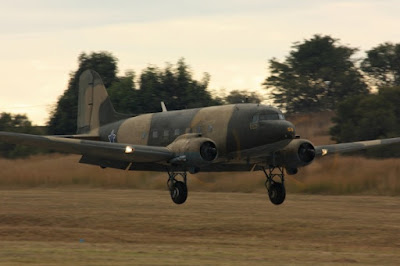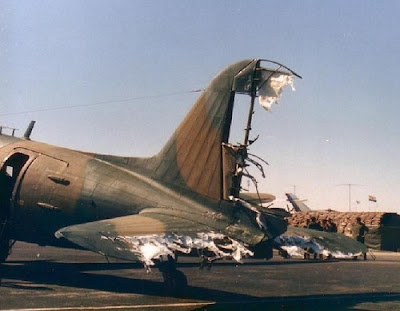A report at The War Zone brought back many military (and other) memories.
After an extraordinary career spanning more than 80 years of service, and plenty of operational missions, the South African Air Force (SAAF) is preparing to retire its last C-47 Dakotas. Remarkably, the SAAF is moving to discard its C-47s while, at the same time, elsewhere around the globe, turboprop versions of the venerable transport continue to win orders.
The story of the Dakota in SAAF service stretches all the way back to 1943 when the service was fighting in World War Two. Most extraordinary, perhaps, is that among the very last Dakotas operated by the SAAF, most had been delivered during that conflict, having started life as C-47s manufactured for the U.S. Army Air Forces (USAAF).
By June next year the South African Air Force will have been operating C-47 Dakotas continuously for 80 years, albeit much upgraded. Even more astounding is that some airframes still in active service have been there from the start, with the oldest (6825) delivered in Feb 1944.
The SAAF’s Dakota fleet, however, saw its most extensive combat service during the long-running conflict in South West Africa (now known as Namibia) and Angola, supporting South African Defence Force (SADF) units during the so-called Border War between 1966 and 1989. The SADF relied heavily on the Dakota for troop transport, resupply, medical evacuation, paratrooping, and other missions, its importance was heightened by the sanctions on Apartheid South Africa that complicated the procurement of alternative equipment.
By the 1980s, the SAAF operated the largest fleet of Dakotas anywhere in the world — close to 50 in total. However, the demise of minority rule in South Africa, and the end of the Border War, saw the Dakota — and the SAAF more generally — switch increasingly to peacetime missions, especially humanitarian work. At the same time, Dakota squadrons were rationalized, and the fleet was reduced in size.
There's more at the link.
The SAAF's C-47's flew in combat zones many times over the years. They were the primary transport for secondary military air routes in South Africa and then-South West Africa (today Namibia), with C-130's and C-160's handling the busier routes. During the Rhodesian War many SAAF C-47's and Alouette III helicopters were "loaned" to Rhodesia, supplementing that country's small Air Force for "Fireforce" anti-terrorist missions and cross-border operations into Zambia and Mozambique. During South Africa's own Border War in the 1980's they were the shorter-range backbone of air transport operations, including one (shown below) that had an argument with a SA-7 Strela anti-aircraft missile and barely made it back to an airport in time to avoid crashing.
I flew many thousands of miles aboard SAAF C-47's, including one that was so old its logbook recorded it dropping paratroopers at Arnhem in 1944 as part of Operation Market Garden - the so-called "Bridge Too Far" airborne assault. It was in remarkably good shape for an aircraft that had been "rode hard and put away wet" for almost 40 years by the time I flew in it. That particular aircraft is still in service, having been converted to turboprop propulsion along with the SAAF's other surviving C-47's. I also traveled aboard the civilian DC-3 transports of Air Cape, flying along the Garden Route to and from Cape Town. Even in the 1980's, dirt and grass airfields were still in use at some of the small towns there, with no all-weather runways. Things could get bouncy during takeoff and landing, and occasionally the pilot would have to make a couple of low passes to chase a cow or two off the runway before he could land!
The SAAF Museum still has a flying example of the C-47 as built, with its original Pratt & Whitney engines. Here's its C-47 showing off at an air display. It's not a very good video, but it's the best I could find on YouTube.
I wonder what the SAAF will buy to replace its C-47's? There's no doubt that it needs a replacement, both for transport and for coastal maritime reconnaissance (both roles currently filled by the C-47), but the SAAF's aircraft fleet is in very parlous condition at present, with a minimal budget and very few skilled maintainers left to keep it flying. The service is a pale shadow of what it was in the 1980's, when it was undoubtedly the premier air force in sub-Saharan Africa, with skills and operational experience on a par with most NATO air arms.
Despite its age and long overdue need for replacement, it'll be sad to see the last of the SAAF's C-47's take a final bow and retire into history.
Peter



Golden opportunity for rich individuals and air groups to save some planes and engines.
ReplyDeleteCheck out Preferred Turbines DC-3 Uodate package. http://preferredturbine-3.com/pt-3-conversion-details.html
ReplyDeleteWay back in BC one of our instructors at a sailplane maintenance school run by Gliding Federation Australia was an aeronautical stress engineer. One of his jobs had been the turbine section of PT 6 turboprops.
ReplyDeleteA discussion migrated to the service life of DC3's - IIRC from here on -
"The people who designed them knew what they were doing. There are 3 wing spars, any one of which will keep the wings on. They knew there would be fatigue problems so there is a schedule of replacement and, if you do that, there is no reason that they can't keep flying".
I had no idea what "wing spars" even were, so I did some googling. It looks like the DC3 had spars from the fuselage to the wing root, then the rest of the wing has separate spars, and the two bits are exhaustively bolted together. Looks neat and obviously worked well, but idk what 3 spars your instructor was referring to. Not saying he was wrong, just wish I knew more, because it sounds absolutely fascinating and I know absolutely nothing! A vid I found in my googling:
Deletehttps://www.instagram.com/the_flying_mechanic_/reel/Czjohzwpf24/
As a "mission kid" in Papua New Guinea in the late 50s, early 60s, I
ReplyDeleteflew in several DC3s (C47s). Sometimes the aisle would be full of New Guinea
citizens, and piles of taro. Sometimes pigs and chickens, as well. Some of the seats were built for paratroopers and were small and made out of
aluminum.
The mission had Cubs,Cessnas and later on Dorniers. Sometimes we flew
on commercial flights and they were all DC3s for many years. Once, in a
Cessna, we were passed by a DC3. It was interesting to see how much
faster the two engined plane was, compared to the single engin Cessna.
On the edge of the Madang Airstrip there were a couple of old German
transport planes parked. Can't recall the name but got the change to
troop through them once or twice.
Back when I was in engineering school, one of the profs explained the reason the DC-3 was so awesome.
ReplyDeleteIn his opinion, aviation had been in existence long enough that there were engineers and designers who had spent decades designing aircraft...and looking at broken ones. They KNEW at some intuitive level exactly where the stresses would be highest.
It was also before aircraft were commodities like hamburgers, something to squeeze every last penny out of their manufacturing cost.
The prof provided a concrete example: Wing spars and other structural elements ALWAYS, if given enough time, crack at the holes where they attach to other major structural elements. The designers of the DC-3 specified that the forgings and extrusions have raised bosses (extra beef) at all such attachment points, even if it meant machining off 95% of the raised surface in the portions of the strut not immediately next to the attachment.
That is a lot of expensive aluminum turned into chips! That is a lot of time on a custom milling machine.
Re PNG planes -
ReplyDeleteMight have been some of these? IIRC they were used as freighters up to the gold fields
https://goodall.com.au/australian-aviation/junkers%20ju52/junkersju52.html
The replacements will come from China first and Russia second, but mostly China. They will not last as long as the C-47- ie a lot more will crash. No more tailwheels. Need the ramp at the back. Quicker loading and easier to move wheeled vehicles. Also takes the stress of cross wind landings.
ReplyDeletetheres a bunch of c123s in the boneyard brand new because the airforce wont let the Army have the organic trasport they need.
DeleteRe " but idk what 3 spars your instructor was referring to"
ReplyDeleteHave a look at the photo of the end of the "fuselage carry-through" in that video of the plane labeled "Flagship"
More re the wing spars -
ReplyDeleteYou can get a better idea from the "3-view" here
http://www.aviation-history.com/douglas/dc3.html
Mentions multiple spars in the text
And don't forget the "DC 2 1/2"
https://www.aulro.com/afvb/flight/234076-douglas-dc-2-5-a.html
20-25 years ago Virgin Airways refurbished a small fleet of DC-3s, restoring them to the 1930s livery airlines had when the DC-3 was introduced, staffed them with female stewardesses in 1930s uniforms, and flew them on day trips between Orlando Executive and Key West. $99 each way.
ReplyDeleteTruly a step back in time. Last time I was there a half dozen were parked at Orlando Exec, IIRC Virgin stopped the flights around 2008, but I may be wrong.No idea where those planes are now.
I have fond memories of watching cattle offload from DC-3's at La Paz, Bolivia. They didn't seem to enjoy the ride over the Andes, but the beef still tasted wonderful. Steaks you could cut with spoon.
ReplyDelete